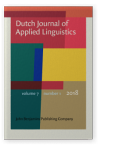Vol. 7:1 (2018) ► pp.89–108
Contextuele invloeden op de productie van /h/ in het Nederlands van Belgisch-Franstalige leerders
The phoneme /h/ is absent in French and its acquisition has been described as being difficult for second language learners of Dutch, a language with /h/ in its phoneme inventory. In this study, several factors were examined that may affect the production of /h/ by Belgian-French learners of Dutch. Specifically, the factors included in this exploratory study were (1) L1-to-L2 transfer, (2) semantic contrastiveness, (3) the monitoring of one’s speech, and (4) educational grade. L1-to-L2 transfer was operationalized as the effect of liaison/elision contexts on /h/-production. The expectation was liaison contexts might transfer and would therefore hinder /h/-production. Semantic contrasts in minimal pairs including an h-initial word would elicit more /h/-productions if that word was contrasted with an empty onset than an onset (oor-hoor) filled by some other consonant (hand-tand). If a speaker pays more attention to his/her speech in an increased-monitoring task, the speaker is expected to produce /h/ more often, and finally it was expected that increased exposure to Dutch would result in more correct productions.
In a cross-sectional study, students from the first, third and sixth grades of secondary education (60 in total, aged between 12 years and 19 years old) took part in two reading-aloud tasks, which were assumed to differ in the degree of speech monitoring they require. The first task was a text, with which L1-to-L2 transfer was assessed, and the second a list of minimal pairs containing h-onsets contrasting with either empty or filled onsets. Monitoring was assessed by comparing results between reading tasks.
Results showed that increased monitoring positively influenced the numbers of [h]s produced, but that L1-to-L2 transfer of liaison/elision contexts did not occur. A small difference between conditions was found, but in the opposite direction. There was large between-learner variability and no performance increase with amount of exposure from first to sixth grade. Overall, performance left much room for improvement relative to native Dutch speakers and to the learners’ teacher. Further research is needed to better understand the development of French-speaker learners’ production of Dutch /h/.
Article outline
- 1.Inleiding
- 1.1Factoren in het leren produceren van L2-klanken
- 1.2Onderzoeksvragen
- 2.Methode
- 2.1Deelnemers
- 2.2Ontwerp
- 2.3Procedure
- 2.4Analyse
- 3.Resultaten
- 3.1Transfertaak
- 3.2Minimale parentaak
- 3.3Monitoring en [h]-productie
- 4.Discussie
- 5.Conclusie
- Dankwoord
- Note
-
Referenties
Article language: Dutch
